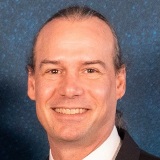Cambridge Healthtech Instituteの第15回年次
Characterization for Novel Biotherapeutics
新規バイオ医薬品の特性評価
Analytical Best Practices for Emerging Modalities
新興モダリティ向け分析法のベストプラクティス
2025年5月15日 - 16日 EDT(米国東部標準時・夏時間)
Sunday, May 11
1:00 pmMain Conference Registration
2:00 pmRecommended Pre-Conference Short Course
SC2: Safety & Efficacy of Bispecifics and ADCs
*Separate registration required. See short course page for details.
Tuesday, May 13
6:30 pmRecommended Dinner Short Course
SC5: Targeting the Target: Aligning Target and Biologic Format Biology to Achieve Desired Outcomes
*Separate registration required. See short course page for details.
Thursday, May 15
7:45 amRegistration and Morning Coffee
NEXT-GENERATION CONJUGATES
Characterization Issues for New Conjugation Chemistries and Platforms
 Wendell P. Griffith, PhD, Lecturer II, Chemistry, University of Texas San Antonio
Wendell P. Griffith, PhD, Lecturer II, Chemistry, University of Texas San Antonio
There has been much recent interest in protein drug conjugates, especially antibody drug conjugates, as an important pharmaceutical class of drugs in targeted therapies which take advantage of the high specificity of antibodies and the potency of small molecule therapeutics. These complex molecules, though, present several analytical challenges including the determination of the drug-to-protein ratio and characterization of conjugation sites. Here we outline some of our experiences using various mass spectrometry-based tools and strategies. The presentation will discuss specific conjugation chemistries used in our work, determination of drug-to-protein ratios and conjugation stoichiometries, and characterization of conjugation sites?.
Monitoring Degradation in ADCs by LC-MS
 Mahalia Serrano, PhD, Principal Scientist, Biologics Development, Bristol-Myers Squibb
Mahalia Serrano, PhD, Principal Scientist, Biologics Development, Bristol-Myers Squibb
The talk will describe LC-MS methods used to characterize degradation products of ADCs. More specifically, mass spectrometry techniques were used to identify and quantify site-specific hydrolysis on the linker and payload. Furthermore, an LC-MS method for determination of the global payload hydrolysis levels was established to enable a more informed control strategy.
In vitro and in vivo Characterization Strategies for Novel Conjugations
 Mei Han, Principal Scientist, Pharmacokinetics, Dynamics, Metabolism and Bioanalytical (PDMB), Merck & Co., Inc.
Mei Han, Principal Scientist, Pharmacokinetics, Dynamics, Metabolism and Bioanalytical (PDMB), Merck & Co., Inc.
Antibody-drug conjugates (ADCs) have become an attractive modality for treating complex diseases. In vivo, ADCs could undergo biotransformation, leading to modifications of the linker-payload and/or changes in the drug-to-antibody ratio (DAR). These modifications could affect efficacy or introduce toxicity. Investigating the in vitro/in vivo stability/biotransformation could provide guidance to linker-payload and antibody selections. In this work, case studies of how biotransformation data informed lead candidate(s) selection or optimization are presented.
 Dominate ADC Characterization with High-throughput, Low Volume analysis on Stunner
Dominate ADC Characterization with High-throughput, Low Volume analysis on StunnerSpeaker to be Announced, Unchained Labs
Antibody-drug conjugates (ADCs) are powerful but challenging - often in short supply and prone to aggregation. With the ever-increasing number and variety of ADCs under development, you need high-throughput, flexible tools to keep up the pace. Stunner gathers three key datapoints on up to 96 ADCs from 2 µL and in 2 minutes per sample: concentration, drug-antibody ratio (DAR), and an aggregation check. This means faster results, less waste, and more time to optimize your ADCs.
10:30 amCoffee Break in the Exhibit Hall with Poster Viewing
11:15 amTransition to Plenary Fireside Chat
PLENARY FIRESIDE CHAT
Riding the Next Biotech Wave-Trends in Biotech Investments, Partnering, and M&As
 Jakob Dupont, MD, Executive Partner, Sofinnova Investments
Jakob Dupont, MD, Executive Partner, Sofinnova Investments
- Emerging Biotherapeutic Modalities, Technologies and Innovations- ADCs, radiopharmaceuticals, GLP-1, AI, machine learning, and other exciting trends to watch
- Introduction to different strategies for investments, M&As, partnering, licensing etc.
- Investing in platforms versus assets
- Advice on funding options for start-ups, early to late stage clinical programs, etc.
12:25 pmLuncheon in the Exhibit Hall and Last Chance for Poster Viewing
Keynote Presentation: Analytical Development Challenges for a Diverse Product Portfolio
 Ivan R. Correia, PhD, Senior Research Fellow & Head, Global Protein Sciences, AbbVie, Inc.
Ivan R. Correia, PhD, Senior Research Fellow & Head, Global Protein Sciences, AbbVie, Inc.
Analytical development with a diverse product portfolio poses unique challenges. Each product, whether it's a cutting-edge biotherapeutic or an innovative genetic medicine, demands customized methods to guarantee quality, efficacy, and safety. Balancing the standardization of processes with the flexibility to meet the specific demands of each product type is no small feat. Overcoming these challenges is where true innovation and teamwork shines, driving the possibility of new, life-changing therapies.
CHARACTERIZATION OF VIRAL VECTORS
Assessment of Adeno-Associated Virus Purity by Capillary Electrophoresis-Based Western
.tmb-0.jpg) Yiling Bi, PhD, Senior Scientist, Sangamo Therapeutics
Yiling Bi, PhD, Senior Scientist, Sangamo Therapeutics
Here we present two CE-western assays for quantifying the relative stoichiometry of VP, and residual levels of a baculovirus protein impurity, GP64. Various purified samples from diverse AAV serotypes were analyzed to determine their VP ratio or GP64 levels. The ratio of VP3/VP1 in rAAV samples was correlated with biological activity, and the clearance of GP64 from the manufacturing process was demonstrated. The results were further supported by LC-MS analyses.
Biophysical Characterization of Viral Vectors and Particulate Impurities in Gene Therapy Products
 Andrea Hawe, PhD, CSO, Coriolis Pharma Research GmbH
Andrea Hawe, PhD, CSO, Coriolis Pharma Research GmbH
There is a high demand to define analytical strategies for the characterization of adeno-associated virus (AAV)- and lentivirus (LV)-based drug products, because it is essential for ensuring safety and efficacy. In this context, both the characterization of the virus itself and the analysis of particulate impurities are crucial. While for AAV, already many biophysical methods to characterize the virus itself have been developed, fewer methods are available for LV. Using a comprehensive set of particle analysis techniques allows us to generate a comprehensive understanding of particulate impurities present in both AAV and LV drug products.
 Advances in Capillary Electrophoresis for Biotherapeutic Development
Advances in Capillary Electrophoresis for Biotherapeutic DevelopmentPeter Johnson, Field Application Scientist & Mgr, Field Applications, Bio Techne
Technical Talk Abstract: In the presentation, Peter Johnson from Bio-Techne will illustrate a novel workflow that leverages icIEF-based fractionation, LC-MS characterization, and SPR analysis, offering a robust and efficient approach to evaluate the charge heterogeneity of biomolecules. The LC-MS characterization revealed similarities in main peaks and notable differences in acidic and basic variants between the innovator and biosimilar. The binding potency analysis showed notable differences in binding affinity, particularly between the biosimilar’s acidic peak and ligand CD20.
4:00 pmNetworking Refreshment Break
CHARACTERIZATION OF mRNA AND siRNA THERAPEUTICS
Characterization of Antibody siRNA Conjugates
 Tun Liu, PhD, Senior Principal Scientist, Biophysics, Johnson & Johnson Innovative Medicine
Tun Liu, PhD, Senior Principal Scientist, Biophysics, Johnson & Johnson Innovative Medicine
Antibody-siRNA conjugate (AOC) has the potential to overcome the obstacles of systemic delivery of siRNAs. To cross the blood-brain barrier (BBB) for siRNA delivery, the antibody must have the affinity to the receptor to allow for brain uptake and subsequently be released for neuronal uptake. We have developed a set of tools to screen for antibodies with such an ideal range of affinity and to assess the stability of the AOCs.
From Structure to Function: Analytical Approaches in mRNA Therapeutics
 Eva-Maria Schneeberger, PhD, Scientist, Analytical Development, Moderna
Eva-Maria Schneeberger, PhD, Scientist, Analytical Development, Moderna
Ensuring the efficacy of mRNA therapeutics requires precise characterization and control of critical quality attributes at both the mRNA and lipid nanoparticle (LNP) levels. This talk explores advanced analytical methods, with a focus on mass spectrometry, to assess essential mRNA attributes-sequence fidelity, purity, cap/tail integrity, and process-related impurities-highlighting orthogonal approaches that support the structural and functional integrity of mRNA therapeutics.
5:30 pmClose of Day
Friday, May 16
7:15 amRegistration Open
INTERACTIVE DISCUSSIONS
Interactive Discussions are informal, moderated discussions, allowing participants to exchange ideas and experiences and develop future collaborations around a focused topic. Each discussion will be led by a facilitator who keeps the discussion on track and the group engaged. To get the most out of this format, please come prepared to share examples from your work, be a part of a collective, problem-solving session, and participate in active idea sharing. Please visit the Interactive Discussions page on the conference website for a complete listing of topics and descriptions.
Particulate Impurity Analysis in Gene Therapy Products: Challenges & Opportunities
Andrea Hawe, PhD, CSO, Coriolis Pharma Research GmbH
- Key challenges and strategies for analyzing particulate impurities in gene therapy products, such viral vectors, mRNA-LNPs, etc.
- What types and sizes of particles should we expect?
- How do we assess impurities, when the active itself is a particle?
- What are key techniques for sizing, counting, characterization, and identification or particles?
- Are particulate impurities cQAs for gene therapy products, as in biologics?
OLIGONUCLEOTIDE THERAPEUTICS
Comprehensive Insights into Antibody-Oligonucleotide Conjugates: Design, Developability, and in vivo Activity
 Maximilian Hartl, PhD, Scientist & Lab Manager, Pharma Research & Early Development, Roche Diagnostics GmbH
Maximilian Hartl, PhD, Scientist & Lab Manager, Pharma Research & Early Development, Roche Diagnostics GmbH
This talk explores the multifaceted approach of combining antibody and oligonucleotide modalities, using Brainshuttle-ASO as a case study for delivering antisense oligonucleotides (ASOs) to the brain. We will discuss the design process, developability, and molecule stability. Closing with in vivo activity data, a holistic view of the journey from concept to practical application will be provided.
Lessons Learned during the Development of Maleimide-Conjugated ASO for Subsequent Functionalization
 Zifan Li, PhD, Senior Scientist, Analytical Development, Biogen
Zifan Li, PhD, Senior Scientist, Analytical Development, Biogen
Functionalization of therapeutic oligonucleotides by conjugating to multiple modalities may be beneficial for their efficacy or delivery. Certain examples like GalNAc have been widely applied in therapeutic ASO and siRNA development. Maleimide-conjugated ASO can be easily functionalized by conjugating to thiol-bearing modalities. During the manufacturing development of such conjugates, we have encountered several difficulties, conquered them, and learned lessons. This presentation intends to share what we learned thus far.
Characterization and Reference Standards for Oligonucleotides
 John P. Marino, PhD, Group Leader, Biomolecular Structure & Function Group, NIST
John P. Marino, PhD, Group Leader, Biomolecular Structure & Function Group, NIST
As emerging therapeutic and vaccine platforms, oligonucleotide-based modalities have shown great success in treating diseases and in COVID pandemic response. Defining and measuring the quality attributes of oligonucleotide-based modalities presents new analytical challenges. To this end, I will describe new measurement technologies and reference materials being developed at NIST to support analytical characterization and harmonization of methods for oligonucleotide therapeutics, from short siRNA and antisense drugs to mRNA vaccines.
10:00 amSponsored Presentation (Opportunity Available)
10:30 amNetworking Coffee Break
OTHER NOVEL BIOLOGICS
An Effective Workflow for Assessing Domain-Specific Charge Heterogeneity in Bispecific Antibodies
 Kai-Ti Chang, PhD, Scientist, Protein Biochemistry, Regeneron
Kai-Ti Chang, PhD, Scientist, Protein Biochemistry, Regeneron
Bispecific antibodies (bsAbs) have emerged as a novel therapeutic antibody format, leveraging two distinct Fab domains to directly bind multiple targets. Although this format enables bsAbs to address complex diseases, each Fab arm is differentially prone to modification, adding complexity to the charge profile. Here we present an effective workflow to characterize charge heterogeneity in bsAbs, using platform-based enrichment followed by domain-specific charge variant analysis, identity, and potency characterization.
A Cation Exchange-High Performance Liquid Chromatography (CEX-HPLC) Method for Identity and Population Characterization of Recombinant Polyclonal Antibody Therapeutics
 Hongjun Yue, PhD, Director, CMC, GigaGen
Hongjun Yue, PhD, Director, CMC, GigaGen
Recombinant polyclonal antibodies (pAb), a new class of therapeutics comprising over 1000 immunoglobulin G1 (IgG) species recognizing multiple epitopes or antigens, are anticipated to be highly effective for treating rapidly evolving infectious diseases. We developed a CEX-HPLC method to address a major hurdle in pAb manufacturing, the reliable characterization of pAb population diversity and identity. The method generates a reproducible and unique profile for a pAb product, is sensitive to lot-to-lot variation in pAb population and can serve as a fingerprint identity assay.
Unlocking the Diagnostic and Therapeutic Potential of Ultrasensitive Extracellular Vesicle and Biomarker Detection using Single Molecule Detection Array (SiMoA)
 Jennifer Pollock, Researcher, Biomedical Engineering, Brown University
Jennifer Pollock, Researcher, Biomedical Engineering, Brown University
A review of methods for isolating and characterizing EVs in order to address the challenges associated with the widespread heterogeneity in the size and composition of EVs. We will present a high-throughput single molecule detection array (SiMoA) for fast immune-phenotyping of extracellular vesicles from low-volume biofluids. The array has been used to observe changes in protein expression across different EV populations and identify key proteins associated with disease progression.
12:30 pmClose of Summit
* 不測の事態により、事前の予告なしにプログラムが変更される場合があります。
アジェンダ・講演者・スポンサー更新
2025年 プログラム
表示する:

工学ストリーム

腫瘍ストリーム

多重特異性ストリーム

免疫療法ストリーム

発現ストリーム

分析法ストリーム

免疫原性ストリーム

新興治療ストリーム

機械学習ストリーム

 Talk Title to be Announced
Talk Title to be Announced
















